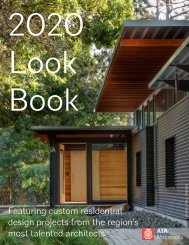2020 Homes by Architects Tour program
See and read about the 17 new and remodeled, architect-designed residential projects that are featured on this year's virtual home tour.
See and read about the 17 new and remodeled, architect-designed residential projects that are featured on this year's virtual home tour.
Create successful ePaper yourself
Turn your PDF publications into a flip-book with our unique Google optimized e-Paper software.
Home Design in the Age of COVID-19
Changes in the way we now use spaces within our home
may have implications on design for years to come.
For many, the COVID-19 pandemic
has turned home into much more
than home: it’s now an office, a
school, a recreation area, and more.
Filling such a wide variety of needs
may be more than a home’s current
design can readily accommodate. How
will residential design respond to the
new ways we define home?
Home offices are already gaining
in popularity. Including a home
office—or two—is a consideration for
homeowners building or remodeling
now, as remote work is predicted to
continue for many even after a vaccine
is available. Designing for space
flexibility and adaptability reigns as
well, as dens or guest bedrooms are
turned into home gyms in the morning,
offices or classrooms during the day,
and a space for family relaxation in the
evening.
Homeowners are also rethinking the
open floor plan concept as they seek
separate spaces for simultaneous
and varied uses. Great design
can help create private spaces
without sacrificing opportunities for
connection and community.
Storage may become even more
important than ever—and not just for
your shelter-in-place kit. Clutter is
known to distract the mind, decrease
productivity, and increase stress.
Homeowners are predicted to further
value ample, sleek storage space in
future designs and remodels as they
spend more time on work and learning
in their living spaces.
The “behind the scenes” aspects of
design may be affected as well. It’s
predicted that more homeowners
than ever will be careful in choosing
finishes that can withstand scrubbing
and disinfectants. As more people
work and complete schoolwork
from home, an increased interest in
better ventilation, high-performance
windows, better daylighting, and
overall energy efficiency will positively
impact utility bills—and occupants’
health.
Outdoor living has already been a
rising trend—and COVID-19 only
reinforces the importance of outdoor
space. Not only can we most safely
interact with loved ones, from a safe
six feet apart, outside, but access
to the outdoors can also boost our
mental and physical health. Creating
further points of connection to the
outdoors is likely to increase in future
home designs.
This isn’t the first time disease has
influenced architecture; outbreaks of
tuberculosis during the 20th century
brought design changes from screened
porches to first-floor half-baths to
clean modernism into common use—
and many of these elements are now
things homeowners desire and enjoy.
While this pandemic doesn’t need
to define home design—or override
designing for the occupants’ unique
needs and desires—it can expand our
ideas of how we shape and use our
space, and inspire you as you design or
remodel your dream home.
Sources:
Living spaces are now serving a myriad of functions in this work- and learn-fromhome
era.
CHAD HOLDER
“17 Architects and Designers” on How the Pandemic
Will Change Our Homes Forever” (Dwell)
“How the Coronavirus Will Reshape Architecture” (The
New Yorker)
“Coronavirus: an architect on how the pandemic could
change our homes forever” (The Conversation)
“Architect speculates how residential design might
change post COVID-19 outbreak” (SF Gate)
6 2020 Homes by Architects homesbyarchitects.org



